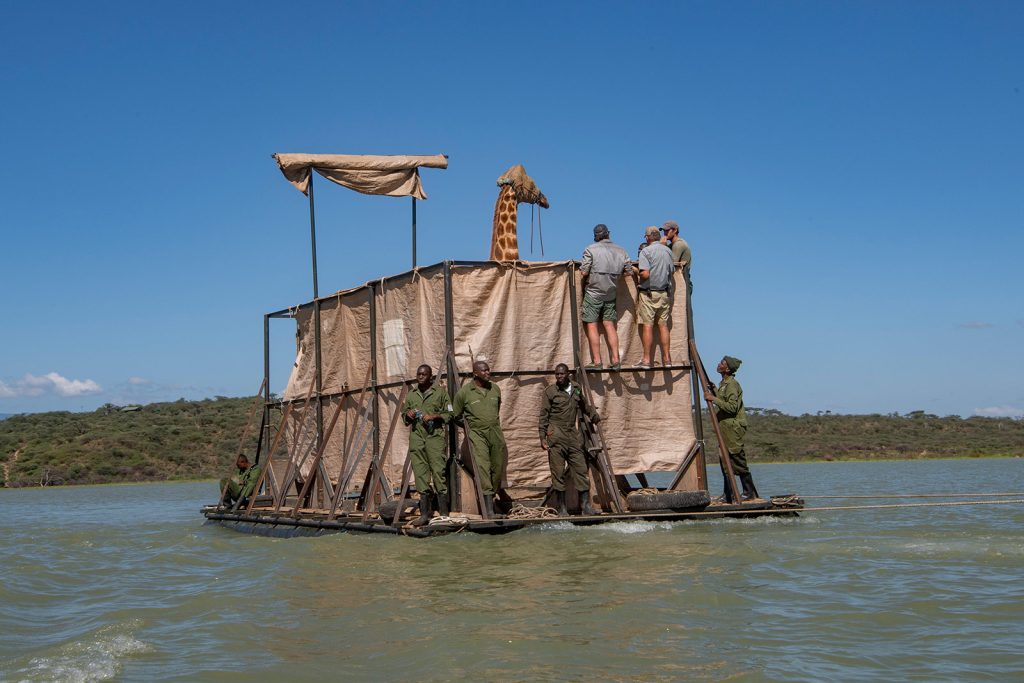The People Who Stuck Out Their Necks for Giraffes
It was December 2020. Asiwa was minding her own business, walking around the only home she ever knew. Suddenly, something struck her and she briefly lost consciousness. When she came to, there were ropes around her shoulders and she was wearing a blindfold. It was clear what her captors wanted her to do — walk forward, into the unknown. She came willingly. One of her captors told CNN that “it looked like someone was walking a puppy on a Sunday afternoon. It was amazing.” Asiwa, still blindfolded, was led onto a barge and outfitted with socks over her ears, to limit her ability to hear. She’d never return home again.
And she’s better off for it.
Let’s start with a picture of Asiwa on the barge.

Asiwa, in case the title didn’t make it clear, is the giraffe pictured above. And she wasn’t being kidnapped. She was being rescued.
Asiwa and eight other giraffes live in Kenya, and before the events depicted above, were the only residents of Longicharo Island, situated on Lake Baringo, a small body of water in the central/western part of the nation. (Here’s a map.) Asiwa and the others lived on Longicharo Island for about a decade, but they never intended to. The giraffes were brought to the island in 2011, but it wasn’t an island at the time. As Atlas Obscura notes, it was “originally an isolated, rocky peninsula lush with acacia trees” and the giraffes were guided there “to try to increase their population away from poachers.” But poachers turned out to be the least of the giraffes’ concerns. Heavy rains came, raising the water level of Lake Baringo and flooding the land bridge to Longicharo Island. The eight giraffes were stranded
That would have ultimately been a death sentence, as Afar Magazine explains:
As the flooding continued, one giraffe named Asiwa became separated from the rest of the giraffes who moved to higher ground. She was stranded on the lower part of the island and trying to survive alongside crocodiles, hippos, warthogs, and deadly, poisonous snakes.
Asiwa was in the most danger, but all eight of these giraffes were at risk. They were going to slowly die because there was not enough food, or they would be killed by predators, or they would be totally flooded out. Their future was bleak, so a plan was devised to move these giraffes to the mainland, a 44,000-acre partially fenced-in conservancy named Ruko. [A group of agencies and nonprofits] came together for this ambitious rescue plan. The long-term goal is to repopulate the whole western Rift Valley—the giraffes’ historical home—in the next 20 to 30 years.
Moving 18-foot-tall giraffes, though, isn’t easy. As Atlas Obscura explains in the above-linked story, “The long-necked grazers are extremely challenging to move around, according to David O’Connor, president of Save Giraffes Now, who was present at the first rescue. Unlike elephants, rhinoceroses, and lions, which can be sedated while being transported, giraffe physiology makes this strategy risky for the animals. ‘Once they’re down and horizontal, which is not a natural position for them, potentially they could choke on their own saliva. Or because of their unique blood flow system, basically, their brain could explode because of the high pressure of the blood going to the brain.’” And if you solve for that, you still need a boat that can transport a giraffe across a mile of open water while keeping it calm — and that didn’t exist at the time.
To solve for that, the conservationists built a barge, seen above, “that is kept afloat by 60 empty drums, decked-out with reinforced walls and pulled by a motorboat [and] named the ‘GiRaft,’” according to Smithsonian Magazine. To get the animals on the GiRaft, the rescuers shoot them with a tranquilizer dart and quickly outfit the giraffes with blindfolds — so they don’t think that a predator is afoot — and guide ropes, and then immediately administer medication to revive the beasts. Then, it’s just a matter of directing the giraffe onto the barge. Once on board, their ears are covered as an additional precaution against a giraffe freakout during the one-mile trip to the mainland.
And the result? A success. In April 2021, the last of the nine giraffes were rescued.
Bonus fact: The Star Wars character named Nien Numb (pictured here) made his galactic debut in the 1983 film Return of the Jedi. He has a very small role, acting as the nonhuman copilot of the Millenium Falcon under Lando Calrissian, so it’s fine if you’re unfamiliar with him. There are probably only two groups of people who know who Nien Numb is: die-hard fans of the franchise, of course, and also, those who grew up in Kenya when “Jedi” came out. On screen, Nien Numb speaks in what most people think is an alien language, but it’s actually not from out of this world. As the Christian Science Monitor reported at the time, “Nien Numb speaks fluent Kikuyu, the dialect of Kenya’s majority tribe.” He became a fan favorite throughout Kenya as a result.
From the Archives: Swooshed in Translation: How a Nike ad created in Kenya went… well, not the way the sneaker brand expected.
